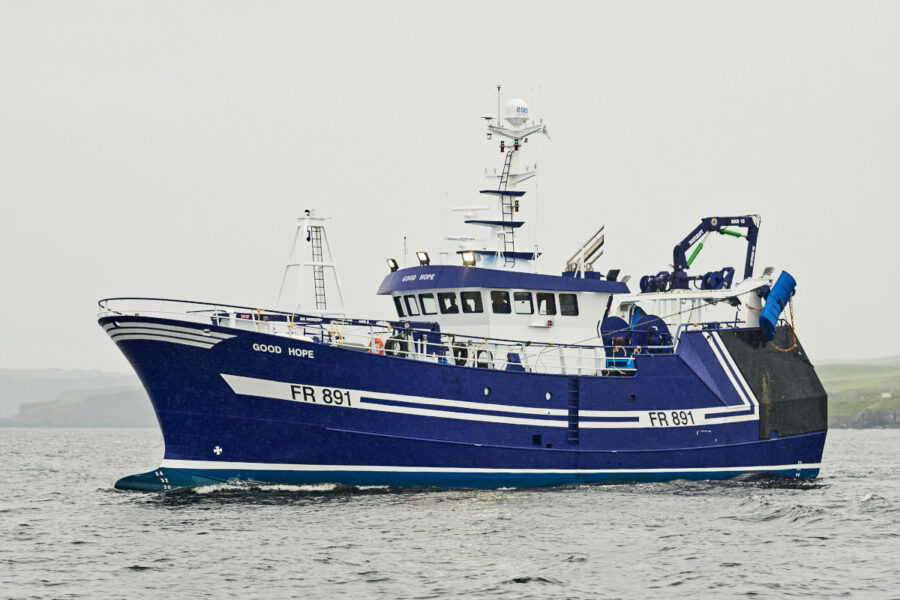Fraserburgh skipper Willie Farquhar and the crew of the 26.5m trawler Good Hope FR 891 fished their first North Sea trip earlier this month, before landing 840 boxes of mixed fish into Peterhead last Tuesday for the midweek market, reports David Linkie
Good Hope is reported to have performed well on her seven-day maiden trip, during which the trawler encountered a spell of scruffy weather that provided an encouraging early indication of the vessel’s seakeeping capabilities.
Good Hope is the latest in a succession of new builds by Macduff Shipyards to be completed ahead of schedule. As a result, the vessel was able to complete two successful back-to-back shakedown trips before being named at Macduff this week, on Thursday, 22 August.
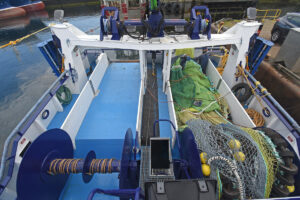
Two single net drums and trawl tracks are arranged abaft the wheelhouse on the shelterdeck.
Designed and built by Macduff Shipyards for the Good Hope Fishing Company Ltd, Good Hope replaces a previous 20.4m wooden-hulled boat of the same name, built at Macduff in 1987 as the pair-trawler Solitaire BF 99 for Grimsby skipper Bob Collins.
From the start of the new Good Hope project, the owners and skippers liaised closely with the yard to develop a vessel that would combine optimum levels of fishing flexibility with good seakeeping qualities and fuel efficiency.
In years to come, Good Hope is expected to fish in a wide arc across the top of Scotland, extending from Rockall to north and east of Shetland.
Given the continuing absence of a crystal ball and any defining clarity on the outcome of Brexit, which has been the one constant factor throughout the design and build of Good Hope, the owners focused on trying to futureproof the vessel as much as possible.
The end result is a vessel with the capability of twin-rig trawling for whitefish or prawns, as well as being equally suitable for either single-boat trawling or pair-seining.
Given the contrasting requirements for these different fishing methods, delivering these took a considerable amount of divergent thinking, particularly in relation to the potentially greater carrying capacity and ice production associated with pair-seining.
As a result, although broadly similar to recent 24m LOA vessels built by Macduff Shipyards, Good Hope features a new hull design. The biggest single difference is that the overall length was increased to 26.5m in order to allow for a larger fishroom, and to fine the underwater lines to help increase efficiency of water flow around the hull to the propeller aperture. The benefits of increasing the hull length are fully obvious from the amount of space available throughout Good Hope, particularly aft of the six net drums located on the quarter and atop the shelterdeck.

General view of the catch-handling arrangements.
The initial hull design began with CFD testing on the proposed model to evaluate resistance and compare it to the previous 24m model, with the CFD study also helping to steer the direction for the final production hull model. At the same time, the stability was calculated and assessed to confirm a good margin over the MCA requirements.
As is customary for the yard, the hull development was the product of close collaboration with Macduff Ship Design, which also provided full stability and kit construction information. The kit construction details were then sent to Macduff Profilers, a division of the shipyard, which supplied the steel kit for the vessel, and the complete vessel was fabricated, engineered and fitted out in the yard’s build hall in Macduff prior to being rolled out on the adjoining slipway.
A few hours before Good Hope sailed on her maiden trip from Fraserburgh harbour, skipper Willie Farquhar said: “The Macduff team was very receptive to our suggestions during the design and build stages, and helped us to customise Good Hope to our personal preferences and specification, by being willing to accommodate all requests effectively every step of the way.
“That Good Hope performed totally as planned and expected on fishing trials says everything about Macduff Shipyards. The level of internal finish and engineering speaks for itself.
“Everyone who contributed to the end result should be very proud of the part they played in building Good Hope. Although no one can predict the fishing opportunities that will be available in the future, either short- or long-term, I’m confident that Good Hope will prove to be a safe, efficient and economical boat to run.”
While boxing and storing a new boat is a red-letter day for all skippers and crew, it was particularly memorable for mate/relief skipper John Watt who, just six hours before throwing off the ropes in the Balaclava basin, learned that he had passed his Class 1 skipper’s ticket following three months of intensive study at the Scottish Maritime Academy, Peterhead.
Insured by British Marine, and working through Peter & J Johnstone (Fraserburgh) Ltd, Good Hope is initially expected to fish trips of six to eight days’ duration, before landing her catches into Peterhead fishmarket.

Good Hope skippers Willie Farquhar and John Watt.
The vessel is of double chine hull form, incorporating a box-section keel with a bulbous bow and transom stern. It features two complete decks and is fully built from Lloyds Grade A steel, apart from the aluminium wheelhouse and mast.
Good Hope has main dimensions of LOA 26.5m, length BP/registered 23.95m, beam 7.80m, depth moulded 4.2m, draft 4.8m and GT 273t.
Below the main deck, from the transom Good Hope is arranged into four compartments: cabin, engineroom, fish hold and forepeak, in which a large freshwater tank is housed.
Under the full-length steel shelterdeck, which is formed as an extension of the hull without a gunwale rail, a watertight full-width deckhouse separates the weathertight catch-handling area forward from the net-handling area on the quarter. The connecting passageway in the deck casing is offset to the port rail.
In line with the now customary practice, an additional bulkhead is fitted forward on the main deck to create a dedicated winch compartment, thereby keeping the trawl wires clear of the fish-handling area.
The winch room is accessed through a dedicated watertight walk-in compartment, housing a 2.5t Geneglace flake ice machine and some of the machinery serving the fishroom chilling system, supplied by Premier Refrigeration.
A similar-sized room is positioned on the starboard side forward of the catch reception hopper, enabling a second ice machine to be easily installed at a later date should Good Hope be used for pair-seining.
Arranged on the starboard side, the immaculately finished combined galley/messdeck features two smaller tables rather than a single bigger one, providing maximum ease of access for the skipper and crew at all times.
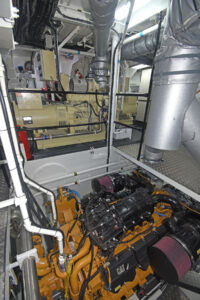
The C32 ACERT main engine and twin Beta Marine gensets.
The usual range of electrical units in the galley were supplied by RD Downie of Fraserburgh which, as customary with all Macduff builds, wired Good Hope and manufactured the engineroom and wheelhouse electrical distribution cabinet boards.
Accessed from the port-side passageway, the deckhouse also includes a spacious shower room incorporating washer and tumble-drier units, in addition to a separate WC compartment. Incorporating bench seating, wash basin and extensive locker storage, the spacious passageway also includes heated storage for the crew’s protective clothing. Crewsaver lifejackets fitted with PLBs and hard hats were among the extensive range of personnel safety equipment supplied by Caley Fisheries of Fraserburgh.
Good Hope’s lifesaving appliances and pyrotechnics came from Caley Fisheries.
Blue Anchor Fire and Safety supplied the vessel’s CO² system and fire extinguishers.
Down the aft stair, the main accommodation cabin is arranged to give eight berths – five to starboard and three on the port side, together with generous locker and drawer storage provision. A separate two-berth skipper’s cabin lies to port, opposite a walk-in compartment housing medical and associated equipment.
Trawling arrangements
Macduff Shipyards manufactured most of the deck equipment installed on Good Hope, including the three-drum trawl winch positioned forward on the main deck in a separate winch room. Rated 30t core pull, the winch is fitted with Hagglund two-speed drive motors for faster hauling and shooting of the wires.
The winch barrels are spooled with 275 fathoms of 22mm-diameter fibre-core wire and an additional 25 fathoms of backing wire.
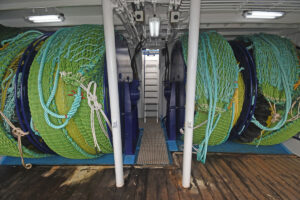
Good Hope’s scraper and discer nets were supplied by Faithlie Trawl and Strachan Trawls of Fraserburgh.
Led up from the drums at nearly 45° to hooded rollers, the outer wires run across the top of the shelterdeck to a second set of sheaves positioned near the forward corners of the wheelhouse, from where they are directed upwards and outwards towards hanging blocks mounted on a conventional trawl gantry. The middle wire runs under the wheelhouse floor before leading upwards to pass over a roller incorporated into the transom rail, directly above a secure track for the safe storage of the middle roller.
A fourth sheave, mounted on the shelterdeck between the side of the hull and the sheave through which the starboard wire runs when Good Hope is either single- or twin-rig trawling, will come into play when the vessel is pair-seining.
Two sets of two 10t split net drums are arranged side by side on the non-watertight wooden-decked quarter, in line with the customary transom shooting and hauling hatches, the lower edges of which are fitted with free-turning large-diameter rollers.
Two more trawls can be carried on single net drums (10t) mounted on the shelterdeck aft of the wheelhouse. These drums are served by long deck tracks leading to an opening across the transom.
The availability of six 10t net drums provides Good Hope’s skippers and crew with a high degree of fishing flexibility at all times. Good Hope is usually expected to carry five nets ready to shoot, leaving a sixth drum free for use in the event of a badly torn trawl.
Thistle Marine Ltd supplied the MKB13 kinked-boom crane and tilting 24in powerblock, which is centrally fitted atop the trawl gantry. Two general-purpose 4.5t gear-handling winches are fitted on either side of the crane to give further options when working the twin-rig trawls. Together with nylon sheaves mounted across the aft end of the wheelhouse roof, the auxiliary winches can also be used to yo-yo torn nets from the quarter up to the shelterdeck.
Catch-handling arrangements
The codends are taken aboard forward on the starboard side by a 5t Gilson winch serving a square-framed lifting gantry arranged over a hydraulically operated hatch and a large-capacity reception hopper, capable of holding over 200 boxes of whitefish.
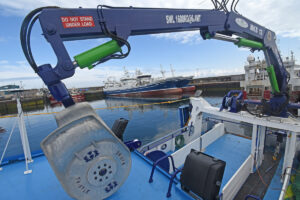
An MKB13 kinked-boom Thistlelift crane, complete with tilting 24in powerblock, is centrally mounted on the trawl gantry between two auxiliary gear-handling winches.
The layout and working arrangements in the catch-handing area forward of the deck casing is customised to the owners’ specific requirements.
A fully integrated aluminium and stainless steel fish-handling system, designed and fabricated by Macduff Shipyards to enhance catch quality while reducing the crew’s workload, lies at the heart of working arrangements.
A transverse conveyor lifts catches from the base of the hopper and across the full beam of the vessel. After being selected and gutted, the main selections of fish are placed in one of the eight elevated selection hoppers available. When full, the contents are released directly downwards into one of four integrated washers. After being cleaned, the selections flow on to a second conveyor positioned along the side of the reception hopper, for delivery via a double pivoting flap and twin chutes to the fishroom for weighing and boxing.
Large monkfish and other species are placed in a trough that runs parallel to the transverse conveyor into a dedicated receiving hopper in which they can be hand-washed by hose, before being returned towards the starboard side for delivery to the fishroom.
Smaller and less frequent selections (including whole prawns and tails) can be made into any of 10 chutes, leading through the main selection hoppers to baskets placed above the washers, or on the main deck at the feet of crewmen standing on raised gratings at the selection hopper forward of the deck casing.
The catch-handling area is kept free of excess water from the fish washers by two deck sumps drained by electrically driven Azcue pumps.
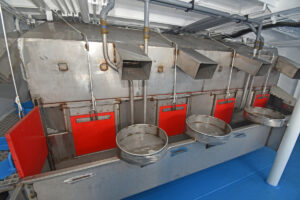
The foreside of the catch-handling system fitted on the main deck amidships.
On delivery to the starboard side of the fishroom, catches are electronically weighed, with part-basket weights stored on the vessel’s VCU catch management system, before a label displaying all relevant information, including species, grade, size, time and date, is printed off and affixed to the end of the corresponding box. This information is also transferred automatically to a PC in the wheelhouse, where it is accumulated to provide a running total of Good Hope’s trips.
The vessel’s fishroom has a working capacity of 1,200-plus stacker boxes, supplied by GKN. Up to 4t of flake ice can be stored in a full-height locker on the port side, directly under the 2.5t Geneglace flake ice machine housed in the dedicated refrigeration plant room on the main deck. Similar storage capacity will be provided to starboard should a second Geneglace ice machine be installed at a later date for pair-seining.
The fishroom refrigeration system, which uses 22mm-diameter stainless steel refrigeration pipes mounted on the deckhead, and stainless steel-sheathed copper piping on the engineroom bulkhead, was installed by Premier Refrigeration Ltd of Fraserburgh.
When landing, a small Gilson mounted on the underside of the shelterdeck is used to pull stacks of boxes forward to the centre of the fishroom, from where they are lifted ashore through a large hatch by a Thistle Marine MFB8 stiff-boom crane served by a 2t landing winch.
Engineroom
Good Hope is powered by a Caterpillar C32 ACERT main engine supplied by Finning UK Ltd.
Developing 492kW @ 1,800rpm and solely dedicated to propulsion duties, the main engine drives a 2,500mm-diameter four-bladed fixed-pitch Wärtsilä propeller, turning in a new design of matching Wärtsilä fixed nozzle through a Masson 9.077:1 reduction gearbox.
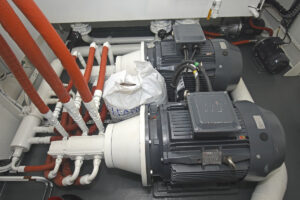
Two 45kW electric-drive pumps provide a full net-retrieve system…
The remaining stern gear package was designed in-house by the shipyard and manufactured by Macduff Precision Engineering on CNC machines. Good Hope is the third fishing vessel built by the yard to be fitted with identical stern gear packages. Fitted with Wärtsilä Deep Sea Seals, the oil-lubricated stern gear packages are reported to be performing exceptionally well, delivering a very smooth and quiet performance in all operating modes and strong towing performance.
As is becoming relatively standard for the yard’s new builds, a triple rudder system is fitted. Over the years, these have proven to be popular with skippers, providing a high level of manoeuvrability and increasing the vessel’s ability to tow across the tide.
The centreline combination gave Good Hope an average top speed of 10.8 knots on sea trials in the Moray Firth. This provided immediate confirmation of the benefits of increasing the waterline length, as indicated by CFD testing during the design of the hull, allied to the efficiency of the chosen centreline machinery package.
A Cummins QSL9 variable-speed auxiliary engine (245kW @ 1,800rpm), mounted on the port tank top, drives the hydraulic pumps for the deck machinery through a Centa drive.
A back-up hydraulic net-retrieve system is powered by two electrically driven pump sets, each of 45kW and capable of running simultaneously if both Beta Marine generators are used.
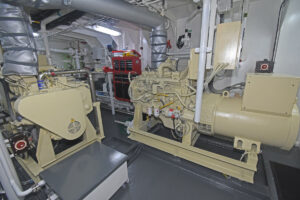
… when both Beta Marine gensets are running.
Electrical supplies onboard Good Hope are provided by two Cummins 6BT5.9D2(M) engines (86kW @ 1,500rpm) driving 81.6kW 415/3/50 Mecc Alte generators. Supplied by Beta Marine, the electrical gensets will usually be run alternately.
Cooling for the four engines and the hydraulic system is provided through freshwater box coolers supplied and fitted by Blokland Non Ferro, arranged across the forward end of the engineroom.
Two electrically driven 150-amp Transmotor alternators provide 24V DC supplies to the four sets of batteries fitted – one for each engine and an emergency bank. A Victron 24V battery charger and inverter are also fitted.
A combination of a 5,150-litre double-bottom tank under the fishroom floor, two 9,650-litre wing tanks and the 1,500-litre daily service tank in the engineroom allow 25,800 litres of fuel to be carried.
A large bulbous bow tank and a double-bottom tank below the fish hold carry 21,800 litres of freshwater between them.
A T700 hydraulic bow thruster supplied by Hardy Engineering is fitted to give Good Hope maximum manoeuvrability when operating in restricted spaces.
First boxes raise £820 for Fraserburgh Mission
The first two boxes of fish landed at Peterhead by skipper Willie Farquhar and the crew of the new Good Hope raised a total of £820 for charity when the longstanding tradition was generously supported by buyers on Peterhead fishmarket.
A box of cod attracted a final bid of £320 from Cowie Seafoods of Peterhead.
The second box, of monkfish, sold for £500 when five local fish-processing companies, AGD Duff & Partners, Whitelink Seafoods, Jack Fish (PD), Seafood Ecosse and G&J Jack (FR), offered to donate £100 each before the sale.
The £820 raised will be donated to Fraserburgh Fishermen’s Mission.
Skipper Willie Farquhar and Good Hope’s crew expressed their sincere thanks to the merchants for their support of the first boxes.
Fraserburgh twin-rig trawls
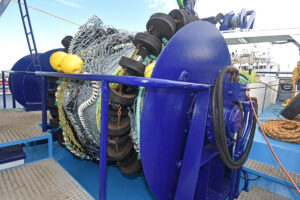
A 220ft scraper net wound on the port-side single net drum atop the shelterdeck.
Two Fraserburgh companies, Faithlie Trawl and Strachan Trawls, made the twin-rig nets now being used by Good Hope.
The choice of suppliers maintains skipper Willie Farquhar’s longstanding association with Willie Hepburn and Bruce Strachan’s teams.
When targeting mainly groundfish on cleaner ground, Good Hope tows two Faithlie Trawl scraper-style nets rigged on 220ft of ground gear made up with 8in- and 10in-diameter discs.
Strachan Trawls supplied three discer nets for use on harder bottom. These slightly higher-standing semi-hopper Rockall-style nets are set on 140ft of 10in- and 12in-diameter ground gear.
Both types of twin-rig gear work in combination with 60 fathoms of 34mm-diameter Malleta steel core combination sweeps, supplied by Jackson Trawls of Peterhead.
The twin-rig trawls are spread by a set of Thyborøn semi-pelagic Blue Stream Type 22 trawl doors with a high-standing surface area of 3m² and weighing 840kg, and a 1,150kg middle roller manufactured by Macduff Shipyards.
Three 275-fathom lengths of 22mm-diameter fire-core wire were supplied by Karl Thomson of Buckie.
Wheelhouse electronics from Woodsons and Furuno UK
The comprehensive array of electronics equipment installed in Good Hope’s wheelhouse was supplied and commissioned by the local Fraserburgh companies Woodsons and Furuno UK Ltd.

Two NorSap skipper’s seats flank a central console.
The majority of the display screens are flush-mounted over two levels in the main forward console, or in the U-shaped fishing console situated to starboard aft, which provides a commanding view of hauling and shooting activities across the stern.
Two NorSap seats flank a small central console, on which the controls for the autopilot and radar sets are mounted.
Including an office area and tea/coffee-making facilities, the spacious wheelhouse is finished to the exemplary high standards for which the Macduff Shipyards team is renowned.
Bottom-sounding and fish detection duties onboard Good Hope are handled by a Simrad ES80 38Hz echosounder and a WASSP F3i (160kHz) multibeam sounder. The multibeam unit provides seabed mapping and real-time ground hardness, enabling the skippers to quickly build up an accurate 3D representation of the bottom they are fishing, so that the trawls can be towed tight to small peaks and ground edges where fish could be lying.
Information from the WASSP is displayed through the MaxSea TimeZero chart plotter.
Olex 3D and Sodena Easywin plotting systems, supporting a combination of AIS, ARPA, tides and charts, are also fitted.
Two Furuno GP39 GPS navigators process details of Good Hope’s location, and vessel heading is provided via a ComNav GPS gyrocompass.
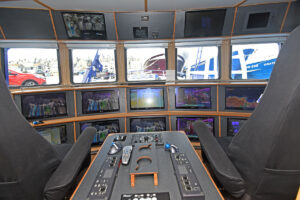
Looking forward over the central island console to the main forward console and overhead displays.
Two Furuno FAR 1513 BB radar units are fitted, served by 6ft and 4ft scanners.
The main radar is a Furuno FAR 2127 X-band unit, backed up by a Furuno DRS6AX set.
Steering is handled by a Navitron NT921G MKII autopilot system complete with three steering tillers and rudder indicators.
Communications and safety equipment includes a Sailor 6310 GMDSS radio telephone, Icom and Sailor VHFs, Easy Navtex, Orton TR-8000 Class A AIS, Orton TRON 60S EPIRB, eSEA 60Ka internet communications and eSEA 80 satellite TV systems.
A total of 16 Neovo X-series 24in widescreen monitors, controlled through an eight by eight-way HDMI matrix complete with iPad control, provide displays from the vessel’s fishing, navigation and CCTV systems.
Installed by Woodsons, the vessel’s CCTV system features images from 10 strategically located cameras, in addition to an underwater camera monitoring the propeller and rudder.
Scanmar Scanbas net-monitoring system
Good Hope is equipped with the new generation of Scanbas 365 multi-trawl software system to monitor her fishing gear.
Supplied, installed and commissioned by the team from Scanmar UK, Peterhead, the system uses the new WDR-42 receiver unit (wideband digital receiver) and the new sensor configuration unit (SCU). Together with the latest 365 software, this allows the sensors to be configured from the multi-display units in the wheelhouse. The system is very similar to the one that Scanmar UK supplied to the new Fraserburgh midwater trawler Taits earlier this year.
Gear sensors include SS4 double-distance units including SS4 clump and SS4 slave sensors, and an HC4-TS150 trawl sounder. The last of these shows the headline height, the headline opening and the clearance from the footrope to the bottom.
A QBC-X1 charging unit was also supplied by Scanmar UK.
Fourth Good Hope in 25 years

The first Good Hope berthed at Campbeltown, after being sold to Portavogie and re-registered B 900.
Good Hope is the fourth boat of the same name that skipper Willie Farquhar has been associated with since 1996.
The first Good Hope FR 891 was bought in 1996 as Harvester PD 98 from Peterhead skipper John Stephen. Powered by a 495hp Kelvin engine, this 21m wooden-hulled vessel was built by Nobles of Girvan in 1978 as Devorgilla BA 67 for Stranraer skipper David Smith. After pair-trawling for herring in the Clyde with Silver Harvest BA 130 for part of each year, Devorgilla moved to Eyemouth in 1982 and was re-registered LH 217, after being bought by James Dougal. Two years later, the boat moved north to Peterhead to be renamed Harvester PD 98, when pair-trawling with Ocean Harvest PD 198. Willie Farquhar sold Good Hope to Shaw Thomson of Portavogie in 1998, when the boat was re-registered B 900, before being decommissioned in 2002.
Skipper Willie Farquhar’s second Good Hope FR 891 arrived in 1998 in the form of the 77ft Endurance II BF 98, previously owned by Joe Nichol. Endurance II was built at the Jones Buckie Shipyard in 1985 as the whitefish trawler Crystal River BCK 16 for Buckie skipper Peter Smith. Six years later, the vessel was renamed Audacious BF 83 by Billy Gatt of Whitehills, before becoming Endurance II in 1995. After twin-rig trawling from Fraserburgh for five years, Good Hope was decommissioned at Kilkeel in 2003.
The third Good Hope FR 891 started fishing from Fraserburgh in 2005, when skipper Willie Farquhar bought the 20.4m trawler Solitaire BF 99 from Shaw Thomson of Portavogie, thereby strengthening the association established in 1998 with the sale of the first Good Hope to Co Down.
The wooden-hulled Solitaire was built by Macduff Shipyards in 1987 as a pair-trawler for Grimsby skipper Bob Collins. After initially pairing with her sistership Sonia Jane BF 31, built in the same year at Macduff for Richardson Seiners Ltd of Grimsby, Solitaire subsequently returned to Macduff for conversion to longlining. Shaw Thomson took Solitaire to Portavogie in 2002, when the vessel was converted back to trawling, returning to northeast Scotland in 2005, since which time the vessel has fished from Fraserburgh and has been extensively refurbished at Macduff.
When the new Good Hope was nearing completion at Macduff earlier this summer, her predecessor was renamed Hope FR 89 before being bought by Peter Willox and George West.

